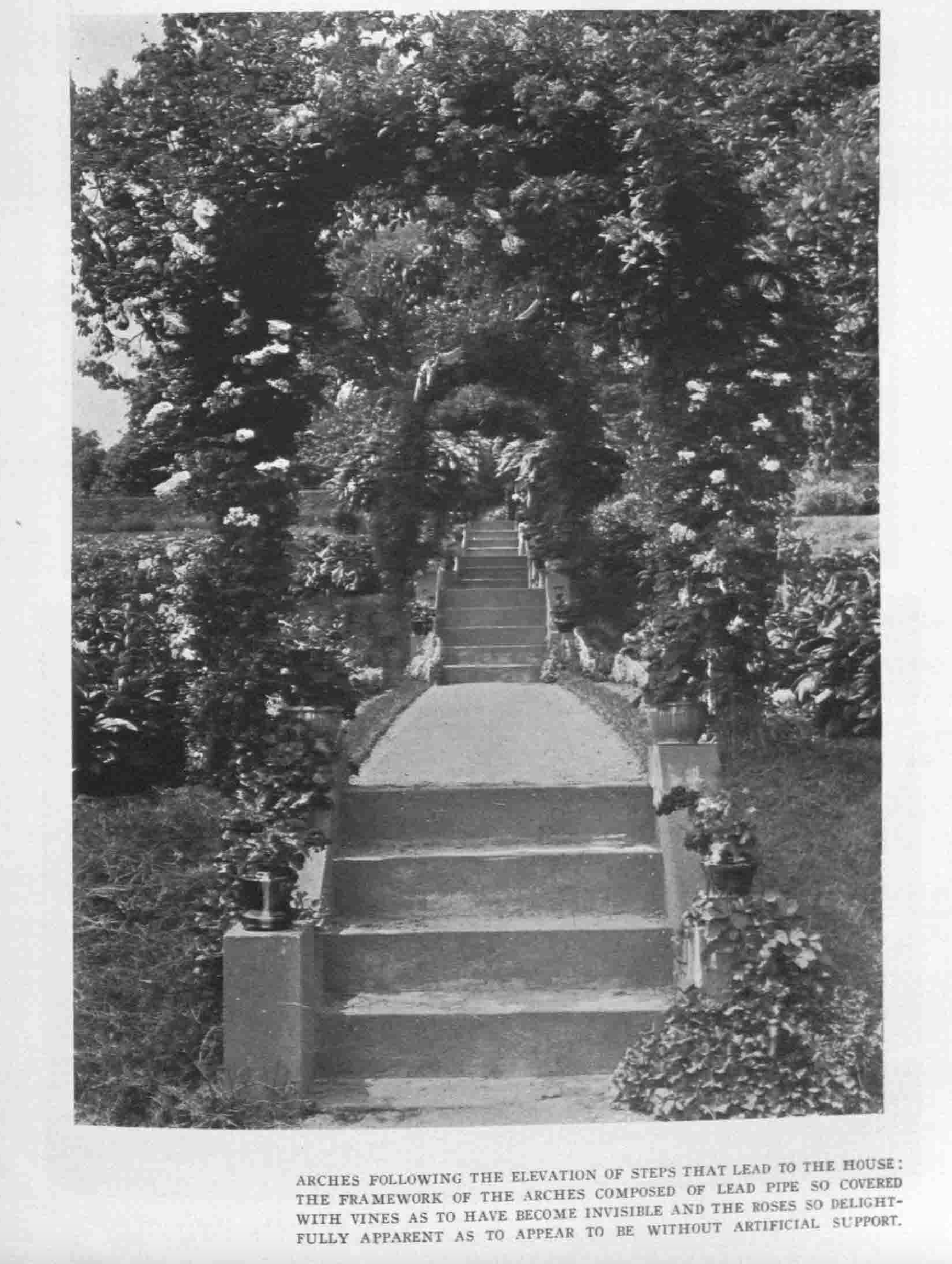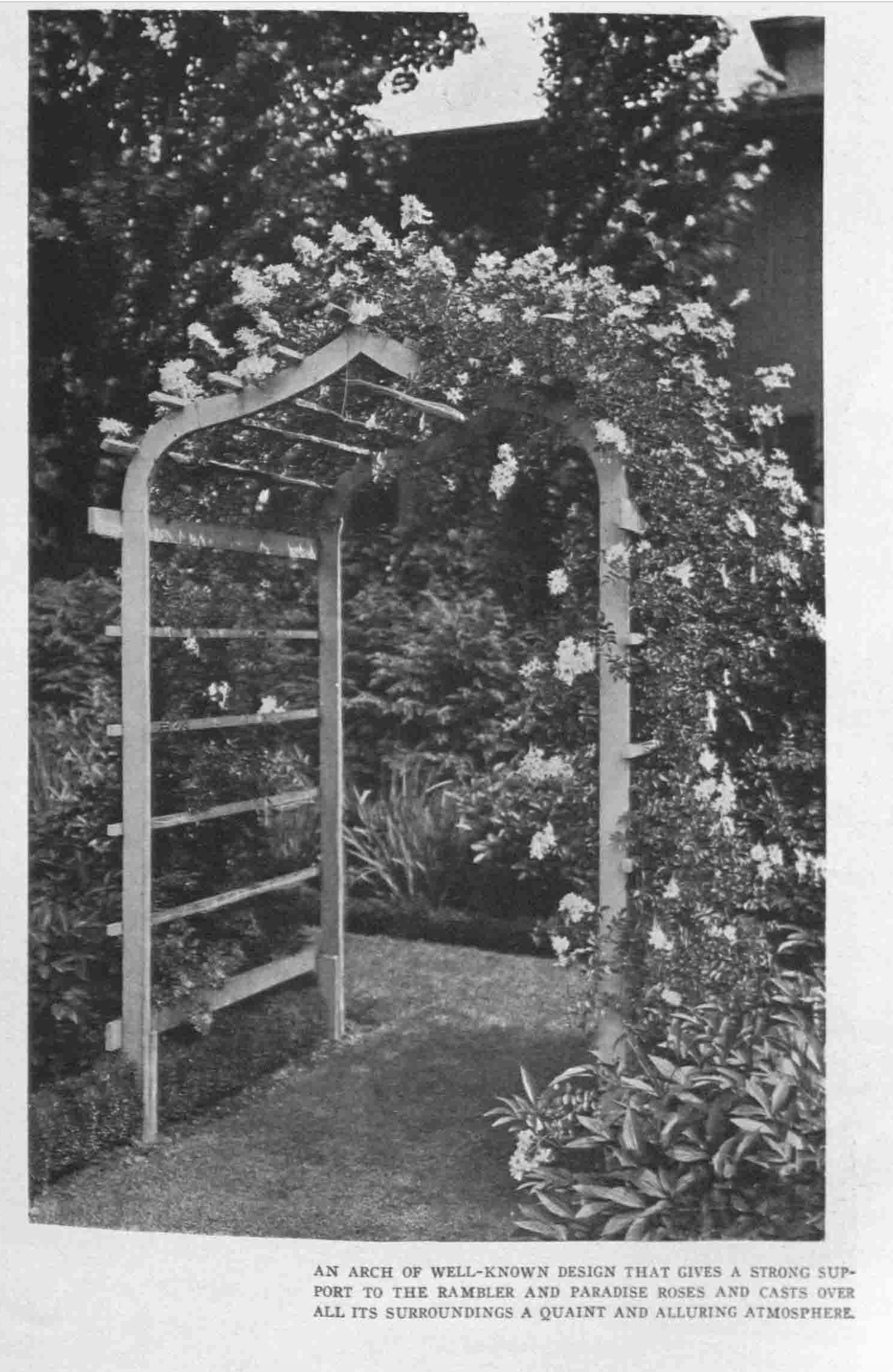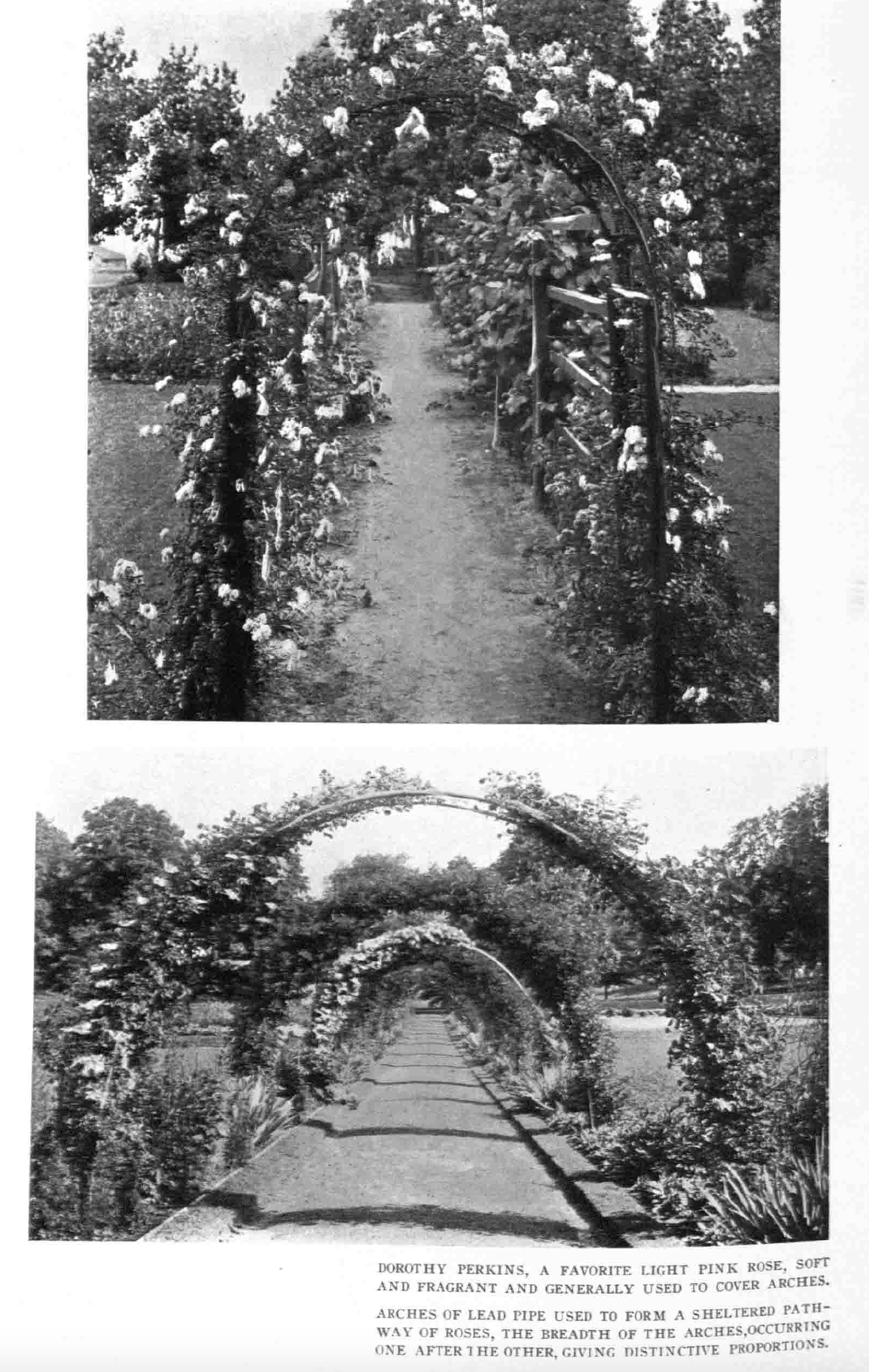Outdoor shelter provided by vine-hidden arches, gateways and trellises.
"Outdoor shelter provided by vine-hidden arches, gateways and
trellises." Craftsman 24, no. 3
(June 1913): 268-275.
[https://library-projects.providence.edu/rosarium/view?docId=tei/rg0023.xml]

In passing under an arch as in crossing over a bridge there is to the imaginative soul ever a suggestion of romance, a little pricking of the emotion as with the occurrence of something unexpected. The bridge suggests the idea of danger conquered, flattering the fancy for achievement; the arch arrests the thoughts, the whole world being seemingly within its shelter. To stand under an arch covered with the blooming things of nature is to have almost within the grasp a bit of the open country confined so that it cannot slip away. When such an arch is covered by a rose vine determined to produce its best or else to die in the attempt, this impression of being closely in touch with nature is heightened, sometimes to such an extent as to be almost overpowering. The arch, the roses, the insects and the individual are so blended into one pulsating existence as to make them for a moment inseparable.
Indeed to confine a bit of open country, as is done by an arch or pergola, is a particularly clever architectural device; it encourages concentration toward some one phase of nature. Many gardens are entirely lacking in the charm to which they are entitled simply because they are laid out too flatly under the broad sky. They have no element of seclusion, no cause for confining the thoughts which can wander off unhindered to distant landscapes or follow perchance a flight of butterflies. The range of the eyes, moreover, is not limited and they are given renownedly to straying.
With the growing appreciation, even if unconscious, of the value of arches, pergolas and the like, their construction has in the last few years improved greatly. Many new and unusual conceptions have given variety to the old-time arch, while the use of hitherto unthought of materials has in many cases reduced their cost, giving them lightness and grace, and making them sympathetic backgrounds for climbing vines, especially roses.
Bamboo and osier have entered a new field of usefulness in the formation of simple arches used to span somewhat narrow pathways. They are not the best choice for holding heavy vines such as Clematis paniculata or Aristolochia Sipho, but for climbing roses they are sufficiently strong; the rose, the aspiring, the beautiful, seldom crushing things by its weight. In fact, a number of bamboo arches set at regular intervals across a pathway form a skeleton for an enclosed path of roses, to linger under which is like living in the heart of a bouquet, a bouquet through which is seen glimpses of the sky and through which the winds of summer blow gently.
Simple arches are also made of lead pipe, lending itself well to the necessary curve of a pathway arch. The color of the pipe, however, is not as harmonious with the wooded part of the rose climber as is the bamboo and the initial cost of its construction is considerably more. On the other hand, it may be argued that the endurance of the lead pipe is greater than that of the bamboo.
In the use of these materials the dominant thought is to produce an arch of roses without visible support and both the pipe and the bamboo can be completely hidden in a comparatively short time, several of the rose climbers throwing out canes at least twenty feet in length in one season. A rose arch laden with bloom wherein all artificial support is hidden, seems then to be a conception of nature springing spontaneously from the ground, enclosing a bit of atmosphere as the translucent rainbow arches the sky. When a series of such arches are planned to follow the upgrade of steps little can be conceived more enchanting or more elevating to the ideals. Beauty seems to have surpassed beauty and to be replaced by fragrant unreality and fancy.
Then there is the semi-concealed arch with somewhat strong woodwork as side piers and a light span of material across the top. Such an arch may be the result of home construction. It does well in places requiring no formality and is not unsightly when the climbers have shed their leaves.
In some places the supports for rose arches are most satisfactory when inconspicuous like those that have been mentioned, while in others where an arch needs to be regarded as an architectural feature it can be painted white. There is something very dignified about a plain woodwork arch of quaint, graceful curves and a central point in the span; an arch that bespeaks a certain chasteness of conception and, at the same time, great simplicity.
One of the best decorative effects is gained when roses are trained on rustic cedar posts so that they form a series of side window frames with top space left clear to the sky. This arrangement is called a rose alley and can lead to a house, a summerhouse or to any place sympathetic with the situation. The rustic posts standing about six feet apart are simply set along each side of the path and one of the hybrid climbing roses planted at the base of each. Then as the roses grow they are trained, not across the pathway pergola fashion, but overhead from post to post in lengthwise direction. Side windows are therefore formed, arched at the top, and permitting vistalike peeps of landscape to those moving along the path. Such a rose alley is in truth a more enchanting arrangement for roses than a pergola. The blooms seem nearer to their lovers, much less obstructed from sight and touch.
Trelliswork fences are another form of the desirable structures on which rose climbers cast forth their clusters of bloom. They can be fashioned to act not only as dividing lines between property, but as screens and barriers shutting off unsightly places. Sometimes the marvel is that a single rose plant can cover as much space as is frequently done on these latticework fences where their growth is undoubtably fostered by the flat way in which they are able to spread themselves out to the air and sunlight, touching them from both sides of the fence.
Trelliswork in many forms has become permanent since the introduction of hybrid climbing roses requiring aid in their efforts to stretch upward. It is seen as an outside breastwork of many new and artistically planned houses of clapboard or cement, materials that do not derive benefit from the clinging touch of vines. In fact, both architects and builders have succumbed to the necessity of providing in their plans proper trellises not only for vines to grow on but as a means of protecting houses from too close association with their destructive qualities. A gentle-looking rose climber can do a very considerable amount of damage to a house if allowed to hug it too closely.
These trellis breastworks however, built at the sides, as extensions of verandas and even all the way around the house rather add to its attractiveness. Many are painted the color of the roof, a roof of green tiles requiring a trellis that matches exactly. Such trellises, besides, are so neat and suggestive of summer in appearance that they keep the house from having an altogether bare look during the winter. They remind the onlooker of their purpose and set his thoughts along the road that leads to their being again covered with bloom.
Gates as well as fences are now contrived, trellislike in effect. In fact, the well-made trellis is the desideratum of the hour.
Things high, in contrast with those low, should occur in every planting ground whether it happens to be a garden or a purely ornamental arrangement about the house and lawn. By the encouragement of contrasting heights in the green things of the earth, a variety of skyline is obtained overcoming monotony by providing an outlet for the imagination. Trellises and arches have long been known to serve well this purpose as also do pyramidal effects gained by roses trained on rustic posts. Even an old tree stump could be made a prominent lawn feature by a rose vine covering it closely.
In connection with the decoration of home grounds there can never be too many roses. No longer are they, especially those that climb, confined to the month of June for their bloom. Owing to the rose-growers’ art many now hold their flowers continuously for at least six weeks, from June until mid-August, having then a recurrence of bloom in the autumn, only vanquished when nipped by frost. The hybrid climbing roses can now be ranked as hardy and enduring vines like the honeysuckle and wistaria. They grow as rapidly, stand the winters well and cover in many instances spaces as closely. For cutting purposes, moreover, the roses born on such climbers are very satisfactory.
So many are the old and tried varieties of climbing roses, so many also the recent excellent introductions that they present to the amateur an embarrassment of riches. Baltimore Belle and Queen of the Prairies, also Dorothy Perkins are among the best-known kinds and hardly surpassed. Lady Gay, another variety about which there is no question of merit, Milky Way, Hiawatha and Paradise, American Pillar, Walsh’s Delight and Lucille, are also wonderful in their habits of growth and bloom. Lucille, the newest of those mentioned bears imposing trusses of blooms flesh pink in tone and tinged with brilliant salmon color.
Lady Gay when well tended and placed has given time and again the reward of showing trusses on which were counted nearly one hundred buds and flowers. These blooms are a soft cerise pink paling as they grow old to blush white. In fact, their color is not sufficiently strong to clash with the red tile roof of a house—a point that has to be borne in mind whenever choosing rose climbers for pergolas and arches on which the reflection of the house roof is seen.
In nature’s broad field there are many arches formed naturally by vines free to grow and twine after their own impulse. They are graceful and suggestive to the home planter. Yet none in the absolute wild equals the rose which with inherent purity has responded to human cultivation and become, as it rightly deserves, the fairest and most sympathetic flower of the home garden. The rose, moreover, growing as a vine has a pliancy that suggests to the creative mind unique ways of displaying its blooms. In one large garden Lady Gay has been trained to form a rose lyre acting as a screen, at some distance in an opposite direction it represents a harp. Before such examples pieces of topiary work seem out of the race.
The rose with all it virtues still holds undauntedly great generosity.




